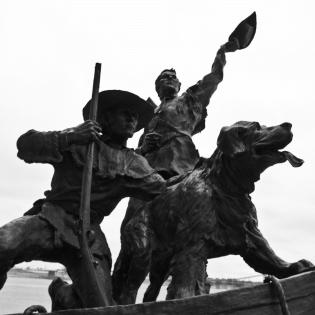A Grand Showing
The purpose of this session is to show and celebrate the completion of the video documentary. Sharing the documentary is an act of philanthropy as it teaches and inspires others about philanthropy in the community. Participants reflect and write about the service-learning experience.
The learner will:
- view and discuss youth-made documentaries.
- determine places to show the documentaries to benefit the community and promote philanthropy.
- completed student documentaries
Make arrangements for a venue to show the youth documentaries to families and community members. Host the party in a room large enough to show the documentaries to a large audience. Or use two rooms: In one room the documentaries loop on a published schedule, and in the other room provide snacks and beverages.
Families and community members are invited to the evening showing of the documentaries.
The Gift of All: a Community of Givers, produced by The S.O.U.L. of Philanthropy along with The Grand Rapids Community Foundation and Calvin College. Copyright © Grand Rapids Public Library, City of Grand Rapids, Michigan, 2008, 2009. Streaming video available at https://www.youtube.com/watch?v=dmaJoQicCEE
Instructions
Anticipatory Set:
On the due date for the documentaries, set up the room like a movie theater and provide popcorn. Show the students' documentaries about the community. Celebrate each project. After each documentary, discuss the theme, philanthropists, and artistic qualities. This may take a couple class periods.
Brainstorm other venues or opportunities for showing the youth-made documentaries to a wider audience. Discuss places to share and donate their documentaries where they will be able to make a lasting contribution to the community (a library, community foundation, schools, etc.).
Plan a release party for the documentaries and design invitations for the release party. Each group is responsible for bringing the names and addresses of those who contributed to their individual projects. They address envelopes and mail out invitations. Invitations will also be sent to members of the town council, school administrators, and parents.
Host the party in a room large enough to show the documentaries to a large audience. Or use two rooms: In one room the documentaries loop on a published schedule, and in the other room provide snacks and beverages. Guests may move between the rooms, but make sure they are quiet and respectful in the viewing room.
Ask youth and families to volunteer to help by bringing food. Ask volunteers to help set up before the party and clean up afterwards. At the party, celebrate the excitement of producing something that will be valued for years to come! At the celebration, ask youth and guests to describe the value of this contribution to the common good of the community. Encourage guests to make suggestions for other places to share/donate the documentaries.
Donate copies of the documentaries to the school library, public library, community foundation, and/or other places of the students' choosing (including online venues). Contact the local newspaper to ask them to post it on their online newspaper.
Philanthropy Framework
-
Strand PHIL.I Definitions of Philanthropy
-
Standard DP 01. Define Philanthropy
-
Benchmark HS.1 Define philanthropy to include giving and sharing; volunteering; and private individual action intended for the common good. Explain how a volunteer individual/group can act for the common good.
-
Benchmark HS.2 Identify and discuss examples of philanthropy and charity in modern culture.
-
-
Standard DP 05. Role of Foundations
-
Benchmark HS.3 List examples of gifts, from a variety of foundations, that are of value to the community.
-
-
-
Strand PHIL.II Philanthropy and Civil Society
-
Standard PCS 01. Self, citizenship, and society
-
Benchmark HS.4 Describe and give examples of characteristics of someone who helps others.
-
-
-
Strand PHIL.III Philanthropy and the Individual
-
Standard PI 01. Reasons for Individual Philanthropy
-
Benchmark HS.4 Cite historical examples of citizen actions that affected the common good.
-
-
-
Strand PHIL.IV Volunteering and Service
-
Standard VS 01. Needs Assessment
-
Benchmark HS.1 Identify a need in the school, local community, state, nation, or world.
-
Benchmark HS.2 Research the need in the school, neighborhood, local community, state, nation, or world.
-
-
Standard VS 02. Service and Learning
-
Benchmark HS.1 Select a service project based on interests, abilities, and research.
-
Benchmark HS.2 Identify specific learning objectives from the academic core curriculum that are being applied in the service-learning project.
-
-
Standard VS 03. Providing Service
-
Benchmark HS.1 Provide a needed service.
-
Benchmark HS.2 Describe the goals of the project and their impact.
-
Benchmark HS.3 Describe the task and the student role.
-
Benchmark HS.4 Demonstrate the skills needed for the successful performance of the volunteer job.
-
-
Standard VS 05. Integrating the Service Experience into Learning
-
Benchmark HS.3 Identify outcomes from the service.
-
-
